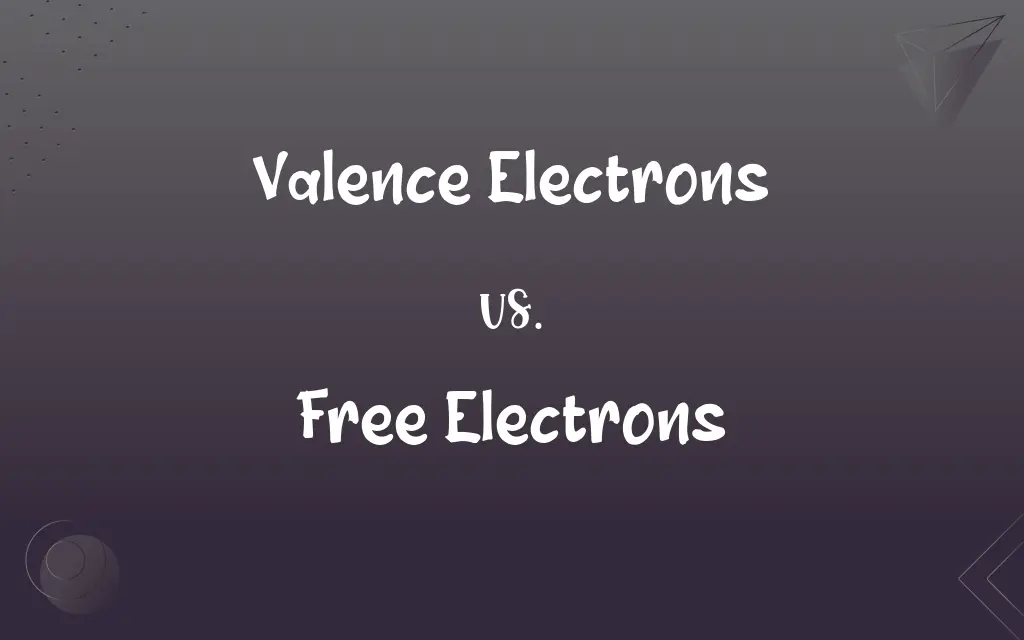Valence Electrons vs. Free Electrons: What's the Difference?
Edited by Aimie Carlson || By Janet White || Published on January 4, 2024
Valence electrons are electrons in the outermost shell of an atom, important in chemical bonding. Free electrons are electrons not bound to atoms, important in electrical conductivity.

Key Differences
Valence electrons are located in the outermost shell of an atom and play a key role in chemical reactions and bonding. Free electrons are not attached to any specific atom or shell; they move freely, often in conductive materials.
Valence electrons determine an atom's chemical properties and its ability to form bonds with other atoms. Free electrons, however, are crucial in electrical properties, as their movement constitutes electric current.
Valence electrons are usually involved in gaining, losing, or sharing electrons during chemical reactions. Free electrons are typically found in metals and are responsible for their conductivity.
Valence electrons can be stable or reactive depending on the element, influencing how an atom interacts with others. Free electrons tend to be in constant motion, especially in an electric field, contributing to electrical and thermal conductivity.
Valence electrons are tied to an atom's electronic structure and are used in determining an element's position in the periodic table. Free electrons are not associated with a particular atomic structure and are more a characteristic of a material, like metal, where electrons can move freely.
ADVERTISEMENT
Comparison Chart
Location in Atom
In the outermost shell.
Not bound to any atom.
Role in Properties
Determine chemical properties and bonding.
Important in electrical conductivity.
Behavior
Involved in chemical reactions.
Move freely, especially in conductors.
Stability/Interaction
Stability varies, important for chemical bonding.
Constant motion, contribute to conductivity.
Relation to Atom
Integral to atomic structure.
Independent of specific atomic structure.
ADVERTISEMENT
Valence Electrons and Free Electrons Definitions
Valence Electrons
Electrons available for sharing or transferring during reactions.
Valence electrons are key in the formation of covalent bonds.
Free Electrons
Electrons that contribute to the conductivity of a substance.
Free electrons are responsible for the thermal conductivity of metals.
Valence Electrons
Electrons in the outermost shell of an atom.
The valence electrons of oxygen determine its ability to form water.
Free Electrons
Mobile electrons not part of an atom's valence shell.
In semiconductors, free electrons play a crucial role in charge transport.
Valence Electrons
Electrons that are involved in forming chemical bonds.
Carbon's four valence electrons make it versatile in organic chemistry.
Free Electrons
Electrons not attached to any atom and free to move.
Free electrons in metals contribute to electrical conductivity.
Valence Electrons
Outer shell electrons that determine reactivity of an element.
The reactivity of alkali metals is due to their single valence electron.
Free Electrons
Unbound electrons in a material, typically metals.
Free electrons enable the flow of current in wires.
Valence Electrons
The electrons responsible for an atom's chemical characteristics.
Sodium loses its valence electron to form ionic bonds.
Free Electrons
Electrons that can move throughout a conductive material.
The flow of free electrons is essential in electrical circuits.
FAQs
What are valence electrons?
Electrons in the outermost shell of an atom.
How do valence electrons affect chemical reactions?
They determine how an atom bonds with others.
Can valence electrons become free electrons?
Yes, in metals where they detach and move freely.
What are free electrons?
Electrons not bound to atoms and free to move.
Are valence electrons always in the outer shell?
Yes, they're defined as the outermost electrons.
How are free electrons related to electrical current?
Electrical current is the flow of free electrons.
What role do free electrons play in conductivity?
Their movement conducts electricity and heat.
Do all atoms have valence electrons?
Yes, all atoms have electrons in their outer shell.
Can valence electrons be shared between atoms?
Yes, in covalent bonds.
Are free electrons always mobile?
Generally, yes, especially in conductors.
Where are free electrons commonly found?
In conductive materials like metals.
How does the number of valence electrons affect reactivity?
Fewer or more valence electrons often increase reactivity.
What materials have a high number of free electrons?
Conductors, especially metals like copper and aluminum.
What happens to free electrons in a superconductor?
They move without resistance, enabling perfect conductivity.
Do all metals have free electrons?
Yes, which is why they are good conductors of electricity.
How do valence electrons affect an element's properties?
They influence chemical reactivity and bonding patterns.
How many valence electrons do noble gases have?
Typically eight, giving them stability.
Do insulators have free electrons?
No, or very few, restricting conductivity.
Why are valence electrons important in chemistry?
They're key in determining how elements react and bond.
Can free electrons exist in vacuum?
Yes, as in cathode rays or vacuum tubes.
About Author
Written by
Janet WhiteJanet White has been an esteemed writer and blogger for Difference Wiki. Holding a Master's degree in Science and Medical Journalism from the prestigious Boston University, she has consistently demonstrated her expertise and passion for her field. When she's not immersed in her work, Janet relishes her time exercising, delving into a good book, and cherishing moments with friends and family.
Edited by
Aimie CarlsonAimie Carlson, holding a master's degree in English literature, is a fervent English language enthusiast. She lends her writing talents to Difference Wiki, a prominent website that specializes in comparisons, offering readers insightful analyses that both captivate and inform.































































